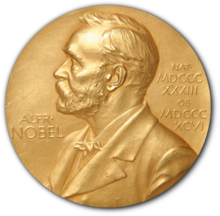
Back Nobelprys vir Fisiologie of Geneeskunde Afrikaans Nobelpreis für Physiologie oder Medizin ALS جائزة نوبل في الطب أو علم وظائف الأعضاء Arabic جايزة نوبل فى الفيسيولوجيا او الطب ARZ Premiu Nobel de Fisioloxía o Medicina AST Fiziologiya və ya tibb üzrə "Nobel" mükafatı Azerbaijani Нобелеўская прэмія па фізіялогіі і медыцыне Byelorussian Нобэлеўская прэмія па фізыялёгіі ці мэдыцыне BE-X-OLD Нобелова награда за физиология или медицина Bulgarian চিকিৎসাবিজ্ঞানে নোবেল পুরস্কার Bengali/Bangla
| Nobel Prize in Physiology or Medicine | |
|---|---|
 | |
| Awarded for | Discoveries in physiology or medicine that led to benefit for humankind |
| Location | Stockholm, Sweden |
| Presented by | Nobel Assembly at Karolinska Institutet |
| Reward(s) | 11 million SEK (2024)[1] |
| First awarded | 1901 |
| Last awarded | 2024 |
| Currently held by | Victor Ambros and Gary Ruvkun (2024) |
| Website | nobelprize.org/medicine |
The Nobel Prize in Physiology or Medicine (Swedish: Nobelpriset i fysiologi eller medicin) is awarded yearly by the Nobel Assembly at the Karolinska Institute for outstanding discoveries in physiology or medicine. The Nobel Prize is not a single prize, but five separate prizes that, according to Alfred Nobel's 1895 will, are awarded "to those who, during the preceding year, have conferred the greatest benefit to humankind". Nobel Prizes are awarded in the fields of Physics, Medicine or Physiology, Chemistry, Literature, and Peace.
The Nobel Prize is presented annually on the anniversary of Alfred Nobel's death, 10 December. As of 2024, 115 Nobel Prizes in Physiology or Medicine have been awarded to 229 laureates, 216 men and 13 women. The first one was awarded in 1901 to the German physiologist, Emil von Behring, for his work on serum therapy and the development of a vaccine against diphtheria. The first woman to receive the Nobel Prize in Physiology or Medicine, Gerty Cori, received it in 1947 for her role in elucidating the metabolism of glucose, important in many aspects of medicine, including treatment of diabetes. The most recent Nobel prize was announced by the Karolinska Institute on 7 October 2024, and has been awarded to Americans Victor Ambros and Gary Ruvkun, for their discovery of microRNA and its role in post-transcriptional gene regulation.[2]
The prize consists of a medal along with a diploma and a certificate for the monetary award. The front side of the medal displays the same profile of Alfred Nobel depicted on the medals for Physics, Chemistry, and Literature; the reverse side is unique to this medal.
Some awards have been controversial. This includes one to António Egas Moniz in 1949 for the prefrontal lobotomy, bestowed despite protests from the medical establishment. Other controversies resulted from disagreements over who was included in the award. The 1952 prize to Selman Waksman was litigated in court, and half the patent rights were awarded to his co-discoverer Albert Schatz who was not recognised by the prize. Nobel prizes cannot be awarded posthumously. Also, no more than three recipients can receive a Nobel Prize in Physiology or Medicine, a limitation that is sometimes discussed because of an increasing trend for larger teams to conduct important scientific projects.
- ^ "The Nobel Prize amounts". The Nobel Prize. Archived from the original on 20 July 2018. Retrieved 29 September 2023.
- ^ "The Nobel Prize in Physiology or Medicine 2024". Nobel Foundation. Retrieved 7 October 2024.